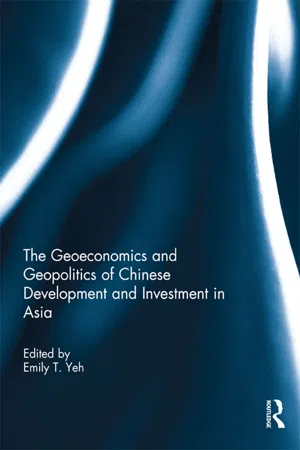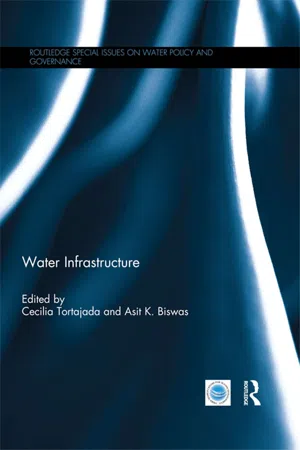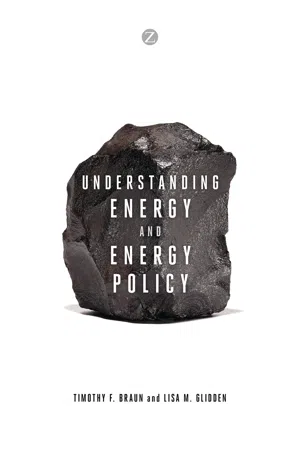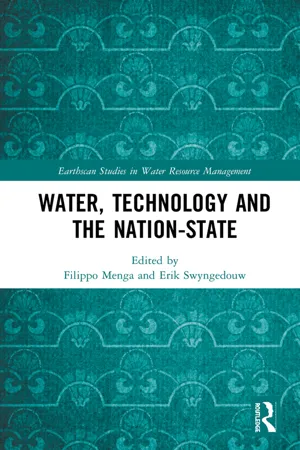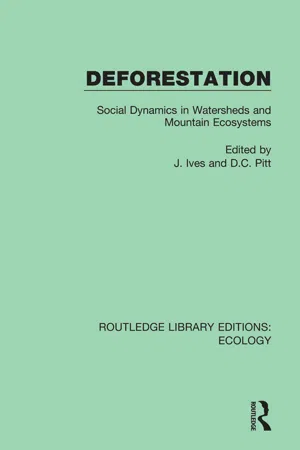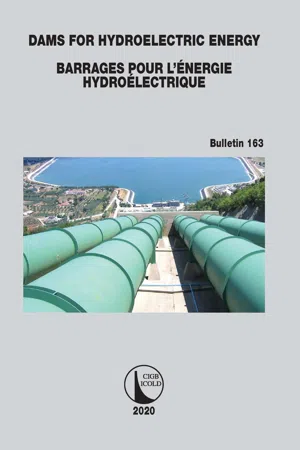Geography
Hydropower in Nepal
Hydropower in Nepal refers to the use of water resources to generate electricity. Nepal has abundant water resources due to its mountainous terrain and rivers, making hydropower a significant source of energy in the country. The development of hydropower has the potential to improve access to electricity and contribute to economic growth in Nepal.
Written by Perlego with AI-assistance
7 Key excerpts on "Hydropower in Nepal"
Learn about this page
Index pages curate the most relevant extracts from our library of academic textbooks. They’ve been created using an in-house natural language model (NLM), each adding context and meaning to key research topics.
- Emily T. Yeh, Emily T. Yeh(Authors)
- 2018(Publication Date)
- Routledge(Publisher)
Despite decades of interventions by a pageant of different actors and institutions, hydropower development in Nepal has been frustrated by an array of geographic, bureaucratic, and geopolitical obstacles (Dixit and Gyawali 2010; Gyawali 2003). Today, as Kathmandu reels under up to sixteen hours of blackouts during the dry winter months, both the material shortage of electricity supply and fears of an escalating energy crisis endow hydro-imaginaries with a moral and social authority to bring about an improved future for Nepal (Lord 2014). In this context, and after decades of undelivered development promises in the wake of the failed Arun-3 Hydropower Project, one frustrated local man from the Arun Valley spoke for thousands of his compatriots, suggesting that “some foreign country should get Nepal and develop it” (Rest 2012, 113).Within the vacuum of local governance that persists across Nepal, hydropower companies are commonly perceived and engaged as development actors, filling voids left open by the Government of Nepal. Vectors of a “spatializing state” (Ferguson and Gupta 2002), these entities not only influence local authorities but have also become key providers of numerous social and structural services. In Rasuwa and other northern districts, the hydropower complex has proved more durable than local officialdom and more effective in “bringing bikas,” providing the roads, jobs, health posts, educational improvements, and other services that the government has failed to deliver (Lord 2016). This allows citizens of Nepal, historically marginalized and on the social and geographical margins of the state, to directly engage with the “gift of development” in ways that pragmatically include and exclude the Nepalese state as an intermediary. As a result of local citizens’ “shares” in hydropower revenues and across a range of multi-scalar projects, experiences with capital, mobility, and other new capacities continue to add velocity to the processes through which hydropower creates new and active kinds of development subjects in Nepal. Articulations of bikas- eBook - ePub
- Cecilia Tortajada, Asit Biswas(Authors)
- 2017(Publication Date)
- Routledge(Publisher)
zabo (which means ‘impounding water’) system, a holistic approach to watershed management practised in Kikruma Village of Nagaland, India, the catchment area at the top of the hill slope is kept under natural vegetation. Ponds with earthen embankments are dug below the catchment area to harvest water for irrigation and livestock. Cattle yards fenced with ordinary branches or bamboo are maintained below the ponds, and the pond runoff water used for cleaning the yards. Finally, the cleaning water, enriched with manure, flows into rice terraces at the lowest level of the slope (Agarwal & Narain, 1997). These systems have important positive externalities, including reduced erosion and short-term water storage for downstream users, and preservation or accumulation of biomass, an important climate change mitigation measure. However, these externalities are undervalued, and typically not compensated. One constraint on these mountain land and water management systems is their high cost relative to returns. The introduction of higher-value products or of policies that compensate for ecosystem services could help mountain people maintain healthy lifestyles in a healthy environment.Mountain water for hydropowerWith growing demand for energy in mountain regions and elsewhere, plus growing environmental concerns, there is a need to transform energy supplies. Traditional biomass fuels remain the major source of energy in the Hindu Kush–Himalayan region, with the dependence rate on these fuels at more than 80% in Afghanistan, Bhutan and Nepal and about 15% in all of India (ADB, 2011). With the rising environmental concerns of deforestation and air pollution, there is a need to carefully consider the role of hydropower. The contribution of hydroelectricity to total commercial energy is about 50% in Bhutan, 17% in Nepal, 13% in Pakistan, 6% in India and 4% in Afghanistan (ADB, 2011), and to the total electricity supply it is about 100% in Bhutan, 92% in Nepal, 74% in Myanmar, 33% in Pakistan, 17% in India, and 16% in China (Hydropower and Dams World Atlas, 2009).The hydro-energy potential of the greater Himalayan region is more than 500 GW (Vaidya, 2012), but the actual capacity harnessed is only a small fraction of this. As a result, there is a severe electricity shortage in the region: the demand–supply gap is more than 15% in Pakistan and about 10% in India and Nepal. Furthermore, the demand is expected to grow at an annual rate of 10% in Nepal, 9% in India, 6% in Pakistan and 5% in Bhutan (ADB, 2011). - eBook - ePub
- Timothy Braun, Lisa Glidden(Authors)
- 2014(Publication Date)
- Zed Books(Publisher)
Peixe 2013 ), mainly in the mining industry. As these countries develop further they will need considerable additional generating capacity. How these countries will meet growing demand largely depends on whether they have additional usable hydropower resources and can obtain funding to develop them. Other renewable sources such as geothermal, wind, and solar might be used as well. They will also be tempted to build fossil-fuel-powered plants.Dams and reservoirsNot every river is suitable for a hydropower dam. The river must have a reasonable gradient, which is the slope or amount of vertical distance covered per unit of horizontal distance. The river valley should also be relatively narrow. Rivers with steep gradients and narrow valleys are found in hilly or mountainous regions that often have significant natural hazard problems, such as earthquakes and landslides. Flat plains are usually not suitable for hydropower, although dams for flood control or public drinking water may be built in these regions.Even if the river has a suitable gradient, dam placement is a complicated process. First the local bedrock of the river valley must be assayed for strength and water impermeability. The dam must hold back millions of tons of water and this is accomplished by transferring the weight of the water into the bedrock around the dam, so the bedrock must be strong enough to take the load. Weak rock types such as shale and mudstone or heavily fractured harder rock are unacceptable foundations for dams. The bedrock must also be mostly watertight. This may seem like a given, but it is not. Many rock types allow significant amounts of water to pass through them; they are water permeable. Sandstones, for instance, can be strong enough to support a dam but are often permeable. As water passes through the rock it weakens the rock structure, which can lead to eventual failure of the dam. - eBook - ePub
- Filippo Menga, Erik Swyngedouw, Filippo Menga, Erik Swyngedouw(Authors)
- 2018(Publication Date)
- Routledge(Publisher)
Benefit sharing and sustainable hydropower: Lessons from Nepal . Kathmandu: The International Center for Integrated Mountain Development.Simpson, E. 2013. The political biography of an earthquake: Aftermath and amnesia in Gujarat, India . London: Hurst.Sneath, D., Holbraad, M. and Pedersen, M.A. 2009. Technologies of the imagination: An introduction. Ethnos . 74(1), pp. 5–30.Swyngedouw, E. 2015. Liquid power: Contested hydro-modernities in twentieth-century Spain . Cambridge: MIT Press.Tamot, S. 2014. A bug’s life. The Kathmandu Post , 29 December: 7.Thapa, M.G. and Shrestha, K.S. 2015. Natural disasters and Nepal’s energy security. New York Times , 25 May 2015, DotEarth Blog [Online]. Available from: https://dotearth.blogs.nytimes.com/2015/05/25/one-two-punch-of-earthquakes-and-landslides-exposes-hydropower-vulnerability-in-nepal/ [Accessed 15 October 2016].Thompson, M., Warburton, M. and Hatley, T. 2007 [1986]. Uncertainty on a Himalayan scale . Kathmandu: Himal Books.Tsing, A.L. 2005. Friction: An ethnography of global connection . Princeton: Princeton University Press.Welker, M. 2014. Enacting the corporation: An american mining firm in post-authoritarian Indonesia . Berkeley: University of California Press.Welker, M. and Wood, D. 2011. Shareholder activism and alienation. Current Anthropology . 52(S3), pp. S57–S69.Weszkalnys, G. 2016. A doubtful hope: Resource affect in a future oil economy. Journal of the Royal Anthropological Institute . 22(S1), pp. 127–146.White, R. 1995. The organic machine: The remaking of the Columbia River . New York: Macmillan.Zarfl, C., Lumsdon, A.E., Berlekamp, J., Tydecks, L. and Tockner, K. 2015. A global boom in hydropower dam construction. Aquatic Sciences - eBook - ePub
Deforestation
Social Dynamics in Watersheds and Mountain Ecosystems
- J. Ives, D.C. Pitt, J. Ives, D.C. Pitt(Authors)
- 2019(Publication Date)
- Routledge(Publisher)
3. Development agencies seem to be paying undue attention to the introduction of alternate energy sources on the assumption that wood-cutting is the primary cause of deforestation when Bajracharya (1983a) has argued that, at least in parts of Eastern Nepal, deforestation is primarily due to the need to build more agricultural terraces to produce more food. This leads to a vital concept introduced by Thompson and Warburton (1985a:129). It is critical to consider the issue of how the forests are perceived. Development agencies and Government perceive them as a renewable resource; some subsistence farmers appear to perceive them as a convertible resource. Unless these diametrically opposed perceptions can be harmonized, no amount of legislation nor any number of development projects will lead to successful reforestation.4. The vicious circle illustrated initially by Eckhoim - fuelwood gathering - increased walking distance - increased use of animal dung - reduced fertilizer input, is grossly oversimplified (Bajracharya, 1983b). In the Kathmandu Valley, for instance, fuelwood is the main growing-season staple fuel, while dung is used for fuel in the winter when less is needed for fertilizer and would be wasted otherwise (pers. comm., K.K. Panday, 1984). The use of dung for fuel is related to ethnicity and not to pressure on forests (Thompson and Warburton, 1985a).Development of hydro-electricity
It has been estimated that Nepal’s hydro-electricity potential is equal to the combined developed and potential capacity of the USA. Regardless of the accuracy of this statement, Nepal has enormous hydro-potential (est. 83 TWH: Sharma, 1976). Only 2 per cent of the national energy requirements are being met by electricity, indicating that much less than 1 per cent of the potential has been harnessed.H.M.G. regards development of the hydro-electric potential as a means of reducing the heavy costs of oil imports, accelerating industrial development, reducing pressure on forests, increasing the irrigated area, providing a major export item (sales to India), and improving the quality of life of its people. Consequently, the Seventh 5-Year Plan calls for massive development of hydro-electricity with a high dam on the Karnali River as a primary objective. This will require a 850 m long dam and a 10-year construction period with an estimated 36 TWH generating capacity. It is necessary, therefore, to examine the implications of this policy decision, not only in terms of its basic economics, but also in terms of social and environmental impacts. - eBook - ePub
- Paul Breeze(Author)
- 2014(Publication Date)
- Newnes(Publisher)
Development elsewhere has been slower but there have been major advances in Asia, particularly in China, in recent years, and many of the countries of South America rely heavily on hydropower for electricity generation. Even so, most of these regions have much remaining capacity, while in Africa hydropower is significantly underdeveloped. Table 8.1 shows the breakdown of global capacity at the end of 2008 based on figures from the World Energy Council’s 2010 Survey of Energy Resources. In spite of its potential and obvious advantages, the development of hydropower can often be difficult, particularly where large projects are concerned. Major hydropower projects are often extremely disruptive and, if not developed sensitively, they can lead to a range of environmental problems. Large hydropower plants, particularly those involving dams and reservoirs, will inevitably change the environment in which they are constructed, leading to displacement of people and wildlife and the destruction of ecologies. With care these changes can be managed, but careless and sometimes reckless development during the second half of the 20th century led to hydropower acquiring a bad reputation during the 1980s and 1990s. Since then the industry has made an effort to reform its practices, and the World Commission on Dams addressed the main problems in Dams and Development: A New Framework for Decision Making. 2 This report proposed a complete reassessment of the criteria and methods used to determine whether a large hydropower project should be constructed. It also laid out an approach to decision making that took account of all the environmental and human rights issues that a project might raise—an approach that should potentially filter out bad projects but allow well-conceived projects to proceed. When projects are well designed and construction is carried out carefully, large hydropower schemes have the potential to transform the lives of those who benefit from them - CIGB ICOLD(Author)
- 2020(Publication Date)
- CRC Press(Publisher)
In Eastern Asia the percentage of people with access to electricity is similar to that of the most developed countries, but in other parts of Asia there are many countries (Afghanistan, Nepal, Cambodia, Myanmar, North Korea, etc.) where this percentage is much lower. Regardless of stellar efforts and significant projects that are in progress for the development of new hydro capacity, only about 20% of hydropower potential has been developed in Asia. In Africa, where 65% of the population do not have access to electricity and the needs are consequently very urgent, only a very small amount of the hydroelectric potential has been harnessed.In the last decade, after a period of serious difficulties and disputes, several important declarations have been adopted in favour of hydropower:At the World Water Forum in Kyoto 2003, the most substantial effort to address the global warming problem, the Declaration of 170 Countries stated: ‘”We recognise the role of hydropower as one of the renewable and clean energy sources, and that its potential should be realised in an environmentally sustainable and socially equitable manner ”’.The 2004 Political Declaration adopted at the International Conference for Renewable Energies acknowledged that renewable energies, including hydropower, combined with enhanced energy efficiency, can contribute to sustainable development, providing access to energy and mitigating greenhouse gas emission.At the 2004 United Nations Symposium on “Hydropower and Sustainable Development”, the representatives of national and local governments, utilities, United Nations agencies, financial institutions, international organizations, non-government organizations, scientific community, international industry associations, made a strong Declaration in support of hydropower. Many important key points are clearly stated in this Declaration, among which are the following:
